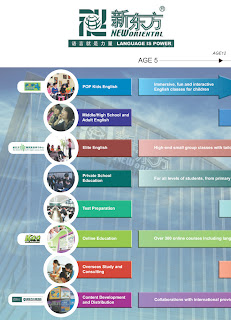The model that my
workplace can fit in is the Technology Adoption Model. The following content
will cover the background information of my workplace, the analysis of my
workplace based on Technology Adoption Model and Diffusion
of Innovation Theory.
1. Background Knowledge about my workplace
I worked as an
English teacher in the largest language training school in Beijing, which is
named New Oriental Technology & Education Group (NOG). It went public in
New York Stock Exchange in 2006, and successfully got more than $10 million
investment to further its infrastructure construction, human resource
reservation, curriculum development and advertisement.
As for the ICT
implementation of the whole school, the objective was stated as to “take
advantage of the power of ICT to make the information presentation clearer and
more attractive”.
By the end of
2006, every classroom in NOG is successfully equipped with one computer for the
teacher, one projector and wall-mounted screens, one interactive whiteboard to facilitate
classroom teaching.
Besides that, NOG
recruited and built up an IT supportive team to solve all the technical
problems met in the classroom, and to train teachers about how to use classroom
electronic devices. By now the IT supportive team is composed of only technicians,
and they have nearly no further contact with teachers except for training
sessions and classroom “e-emergency”.
The technical
training for all teachers was organized once a month, and there is no mandatory
school discipline for teachers to participate in the training.
2. The analysis of NOG based on Technology Adoption
Model
2.1 Matched Characters of NOG and Technology Adoption
Model Schools
Law and Yuen’s
case study(2000) revealed that technology adoption model schools are usually
characterized by the following points:
- No strong school tradition or culture regarding a distinctive school vision and mission
- Main objectives of ICT implementation: enhancing teacher effectiveness and efficiency and student ICT competence
- Strong top-down (autocratic) leadership - the principal is the main change agent
- Focus on infrastructure and technical training of teachers. The school often has clearly defined targets and schedules for achieving specific ICT technical competencies
According to the
stated information in “Background Knowledge about My Workplace”, NOG suits most
of the above characters, but there is still some difference. NOG’s objectives
of ICT implementation do not mention anything about students’ ICT competence;
because NOG is a private school that stresses making profits more than actual
effective learning, and if something is not directly related to making money,
NOG would not include it into its objectives, just like “students’ ICT
competence”.
2.2 The analysis based on Diffusion of Innovation
Theory
Diffusion of
innovation Theory (1997) clearly described the process of technological
adoption, which can be applied to NOG’s ICT implementation process to make the
explanation easier.
The decision to
implement ICT on a large scale can be counted as “authority-based innovation” (1997),
for NOG’s management structure is strong top-down management, but whether to
implement ICT devices is not mandatory for teachers.
The training given
by technicians to teachers started immediately after installment of all devices
in classrooms in 2006. The discussion content of each department’s teacher
meeting also made how to implement classroom devices effectively an important part
since 2007, which is believed to spread relevant knowledge more effectively.
The above conditions
fit well with technological adoption description of Diffusion of innovation
Theory. However, as for the gradual change in NOG, I have not enough data to
check whether NOG’s staffs’ ICT implementation condition matches the following
bell curve graph.
3. The problem the current ICT implementation of NOG
NOG is currently
using ICT as tools that facilitate information presentation and processing. The
very pedagogy all curriculums are based on has no big changes. The approach of
teaching/learning is still in the old way: One teacher continuously speaks to
students, and the interaction between teacher and students is strictly
controlled by the teacher. The phenomenon is described as “old wine in new
bottles” by Lankshear (2000).
In such a
condition, whether learning efficiency is enhanced due to ICT implementation is
hard to conclude. However, NOG is more a corporation seeking profits than a
school that aims at educating students. The solution to the current predicament
will be systems approaches that involve the whole education system outside NOG.
Reference:
Law, N., Yuen, H.K., Ki, W.W, Li, S.C., Lee,
Y. & Chow, Y. (2000). Changing Classrooms: A Study of Good
Practices in Using ICT in Hong Kong Schools. Hong Kong: Centre for Information Technology
in School and Teacher Education, The University of Hong Kong.
Lankshear, C.,
Snyder, I. and Green, B. (2000). Teachers and Technoliteracy: managing
literacy, technology and learning in schools. St. Leonards, NSW. Allen &
Unwin.
Rogers, E. M.
(2003). Diffusion of Innovations. New York: Free Press.


According to the paper, I have a well understanding regarding to the largest language teaching school---NOG. Technology Adoption Model maybe is more suitable for this organization. Just like the point you have mentioned in this paper, the NOG is the profitable organization and pay more attention to apply innovation technology for attracting the students.
ReplyDelete